Create successful ePaper yourself
Turn your PDF publications into a flip-book with our unique Google optimized e-Paper software.
TB: ROUTINE CAREAssess the patient with TB at diagnosis, at 2 weeks and then once a month throughout TB treatment.Assess When to assess NoteSymptoms Each visit • If respiratory rate ≥ 30 breaths/minute, prominent use of breathing muscles, breathless at rest or while talking or confused or agitated, give urgent attention 55.• Expect gradual improvement on TB treatment. Refer for doctor review if symptoms worsen or do not improve.Contacts At diagnosis and if symptomatic Screen household contacts who are symptomatic, < 5 years or have HIV.Family planning At diagnosis and each visit Assess contraceptive needs 91. No need to change interval between injectable doses. Avoid oral contraceptives, use instead injectable or IUCD plus condoms.Adherence At diagnosis and each visit • Request patient brings all medication to each visit. Check adherence with the community care worker, on the TB card and/or with a pill count.• Manage the patient who interrupts TB treatment 58.Side effects At diagnosis and each visit On starting TB treatment, advise patient about possible side effects 58 and to report these promptly.Substance abuse At diagnosis; if adherence poor If > 21 drinks/week (man), > 14 drinks/week (woman) and/or > 5 drinks/session or misuses illicit or prescription drugs 83.Weight At diagnosis and each visit • Expect gradual weight gain on treatment. Adjust TB treatment dose with weight gain 58. Refer same week for doctor review if losing weight on treatment.• BMI is weight(kg)/[height (m) x height (m)]. If < 18.5, refer for nutritional support.Chest X-Ray Not routinely, but only if needed Do chest X-Ray at 2 months if patient diagnosed with pleural effusion. Do chest X-Ray same day if patient deteriorates or coughs ≥ 1 tablespoon of blood.Smear microscopy result At diagnosis Register as smear negative or smear positive depending on result.LPA 1 or DST 2 result If sent during diagnostic workup If LPA 1 or DST 2 sent during diagnostic workup show drug sensitivity, continue treatment. If any drug resistance, refer to doctor.1 spot sputumspecimen for smearmicroscopy 3• Week 7: response to treatment• Week 23: treatment outcomeCheck smear microscopy regardless of smear result at diagnosis and interpret result:• If smear negative at 7 weeks change to continuation phase at end of week 8.• If smear positive at 7 weeks manage as per 7 week algorithm 59.• Use 23 week sputum result to determine treatment outcome below.Treatment outcome 6 months • If smear negative at 23 weeks, stop treatment at the end of week 24 and register treatment outcome:--If smear positive at diagnosis and smear negative at 7 weeks (or if taken, 11 weeks) and smear negative at 23 weeks, register as cured.--If smear negative at diagnosis, register as treatment completed.--If smear positive at 11 weeks and smear negative at 23 weeks register as treatment completed.• If smear positive at 23 weeks manage as per 23 week algorithm 59.HIV If status unknown Test for HIV 60. Give the HIV patient routine HIV care and ART irrespective of CD4 or stage 61.CD4 to decide timingof ART in HIVHIV patient not on ART:at diagnosisIf not already on ART, start ART once tolerating TB treatment:• If CD4 ≤ 50 start ART within 7 days.• If CD4 > 50 and stage 3, start ART within 2–8 weeks of starting TB treatment.• If patient has TB meningitis, start ART within 4–6 weeks of TB treatment.Advise the patient with TB• Refer for TB/HIV education and adherence support. Arrange clinic DOT for the first 2 weeks of treatment and then arrange for community care worker or workplace support.• Educate patient about TB treatment side effects 58 and to report these promptly should they occur.• Advise patient on when to return to work: if on drug-sensitive TB treatment, after 2 weeks; if on drug-resistant TB treatment when culture is negative.• Advise the patient abusing alcohol and/or illicit or prescription drugs to stop. Substance abuse can interfere with recovery and adherence to treatment. Urge the patient who smokes to quit.Treat the patient with TB 58.1Line Probe Assay detects TB drug resistance. 2 Drug susceptibility testing. 3 Make every effort to obtain sputum, even if early morning or by nebulisation.57



